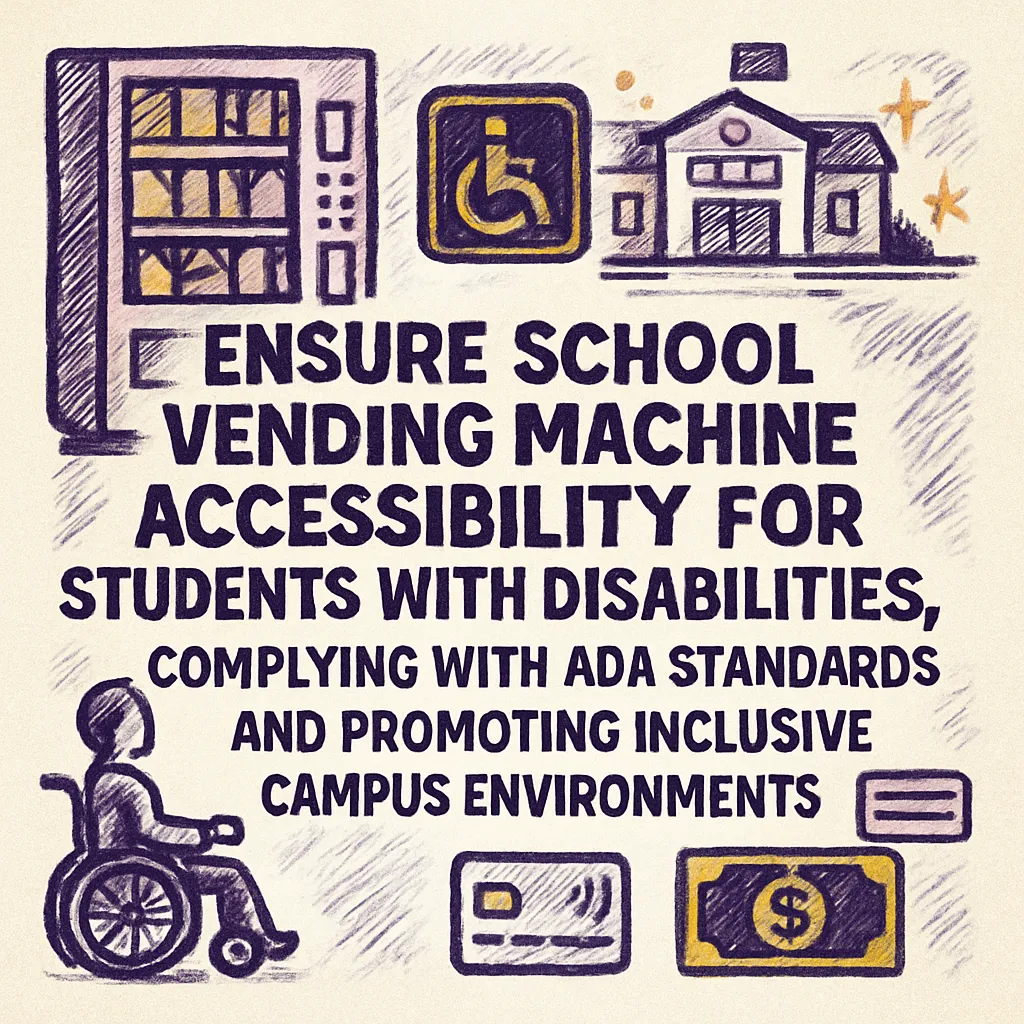Vending Machine Accessibility for All Students
Ensure school vending machine accessibility for students with disabilities, complying with ADA standards and promoting inclusive campus environments.
Back to Vending for Schools ResourcesEnsure school vending machine accessibility for students with disabilities, complying with ADA standards and promoting inclusive campus environments.
Back to Vending for Schools ResourcesEnsuring vending machines on school campuses are accessible to all students, including those with disabilities, is crucial for fostering an inclusive and accommodating learning environment. Compliance with ADA standards means thoughtful placement, design, and usability for every student.
![]() ADA-compliant design ensures equal access for all students
ADA-compliant design ensures equal access for all students
![]() Promotes inclusivity and dignity for students with disabilities
Promotes inclusivity and dignity for students with disabilities
![]() Modern features enhance user experience for diverse needs
Modern features enhance user experience for diverse needs

Creating an equitable and inclusive learning environment means considering the needs of all students. Vending machine accessibility on campus isn't just about compliance; it's about providing dignity and equal access to refreshments and necessities for students with disabilities. Modern vending solutions are designed with accessibility in mind, ensuring that every student has a seamless and independent experience.
The Americans with Disabilities Act (ADA) sets specific guidelines for public accommodations, including vending machines, to ensure they are usable by individuals with various disabilities. For schools, this means considering factors like clear floor space for wheelchair access, appropriate height ranges for controls, and easy-to-use payment systems. Adhering to these standards is not merely a legal obligation but a commitment to an inclusive campus culture.
Key aspects of ADA-compliant vending machines for schools include:
When selecting vending machines for a school, administrators should prioritize models that incorporate these accessibility features. Many contemporary machines integrate touchless payment options, large displays, and ergonomically designed selection buttons that intuitively cater to a wider range of users. These features not only enhance accessibility but also improve convenience for the entire student body.
Beyond the machines themselves, careful planning of their placement is vital. Vending machines should be located in areas that are easily navigable, with clear pathways and adequate lighting. Avoiding cluttered corridors or areas that require navigating multiple obstacles ensures students using mobility aids can reach their desired refreshment without difficulty. For a broader look at how schools manage their vending programs, consider reviewing our School Administrator Guide to Vending.
Schools also have options for promoting wellness through their vending choices. Stocking machines with nutritious snacks and beverages supports student health, which is especially important for growing minds. This aligns with broader initiatives to offer healthy vending machines for schools, ensuring accessible machines offer beneficial options. Embracing accessible vending contributes to a campus where every student feels valued and can partake fully in school life, reinforcing the institution's commitment to diversity and inclusion. Furthermore, understanding the vending machine safety in schools is also crucial for overall student well-being.
If you're exploring vending options for your school, Vending Exchange can help simplify the process. Machine delivery, installation, and equipment are provided at no cost, allowing you to focus on creating an inclusive environment. Fill out the form on this page to get started.
It means ensuring vending machines are easily usable by all students, including those with physical disabilities, visual impairments, or cognitive differences.
ADA standards require features like appropriate height for controls and coin slots, clear pathways, and compliant payment systems to ensure accessibility for individuals with disabilities.
Controls, coin/card slots, and product delivery should be within accessible reach ranges for wheelchair users, typically between 15 and 48 inches from the floor.
Yes, high contrast buttons, clear labeling, and potentially tactile indicators can greatly assist visually impaired students in making selections.
Maintaining an unobstructed path at least 36 inches wide, free from obstacles, allows for easy access for wheelchairs and other mobility devices.
While some accessible features might add to the initial cost, many modern machines are designed with accessibility in mind, and the long-term benefits of inclusivity often outweigh the difference.
Cashless payment options like card readers and mobile pay are often more accessible than coin-only slots, especially for students with fine motor skill challenges.
School administrators, facilities managers, and vending service providers share responsibility for ensuring compliance with accessibility standards.
Some older machines can be retrofitted with accessibility features, but for others, upgrading to newer, compliant models may be more practical and cost-effective.
They foster an inclusive campus, ensure equal access to refreshments for all students, promote student well-being, and comply with legal requirements.